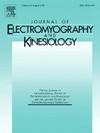利用HDsEMG单峰定位绘制肌肉活动图。
IF 2.3
4区 医学
Q3 NEUROSCIENCES
引用次数: 0
摘要
使用肌电图(EMG)的人机界面在假肢控制、康复评估和辅助技术方面提供了有前途的应用。这些应用程序依赖于解码肌肉收缩激活模式的高级算法。本文提出了一种评估和解码肌肉活动的新方法,通过定位来自前臂背侧的高密度表面肌电记录中单个时间峰的起源,在低力手指伸展期间。通过在空间域中应用表面高斯拟合对电极网格通道上的变化幅度进行定位。局部肌电图峰值用于估计每个手指的不同肌肉体积,在10个受试者中显示高度一致性。结果表明,产生每个动作的肌肉区域是高度不同的,这表明了手指之间肌肉纤维的潜在结构差异。估计的体积进一步用于将单个肌电峰分类为每个相应的动作。在10名参与者中,食指、中指、无名指和小指伸展动作中,每个动作正确分类的峰值百分比分别为79±18%、84±9%、76±13%和79±9%。所提出的体积分析提供了一种新的方法来评估空间激活模式在紧致肌肉解剖;单峰分类方法为近乎瞬时识别肌肉激活提供了可能。本文章由计算机程序翻译,如有差异,请以英文原文为准。
Muscle activity mapping by single peak localization from HDsEMG
Human-machine interfaces using electromyography (EMG) offer promising applications in control of prosthetic limbs, rehabilitation assessment, and assistive technologies. These applications rely on advanced algorithms that decode the activation patterns of muscles contractions. This paper presents a new approach to assess and decode muscle activity by localizing the origin of individual temporal peaks in high-density surface EMG recordings from the dorsal forearm during low force finger extensions. Localization was performed using a surface Gaussian fit applied in the spatial domain to the varying amplitudes across the channels of the electrode grids. Localized EMG peaks were used to estimate different muscle volumes for each finger, showing high consistency across 10 subjects. The results suggest that muscle regions generating each action are highly distinct and indicate potential structural differences of muscle fibres between digits. The estimated volumes were further used to classify individual EMG peaks into each corresponding action. The percentage of correctly classified peaks for each action across 10 participants were 79 ± 18, 84 ± 9, 76 ± 13, and 79 ± 9 percent for index, middle, ring, and little finger extension, respectively. The presented volume analysis provides a new approach to assessing the spatial activation patterns in compact muscle anatomies; and the single peak classification approach opens up possibilities for near-instantaneous identification of muscle activations.
求助全文
通过发布文献求助,成功后即可免费获取论文全文。
去求助
来源期刊
CiteScore
4.70
自引率
8.00%
发文量
70
审稿时长
74 days
期刊介绍:
Journal of Electromyography & Kinesiology is the primary source for outstanding original articles on the study of human movement from muscle contraction via its motor units and sensory system to integrated motion through mechanical and electrical detection techniques.
As the official publication of the International Society of Electrophysiology and Kinesiology, the journal is dedicated to publishing the best work in all areas of electromyography and kinesiology, including: control of movement, muscle fatigue, muscle and nerve properties, joint biomechanics and electrical stimulation. Applications in rehabilitation, sports & exercise, motion analysis, ergonomics, alternative & complimentary medicine, measures of human performance and technical articles on electromyographic signal processing are welcome.

 求助内容:
求助内容: 应助结果提醒方式:
应助结果提醒方式:


